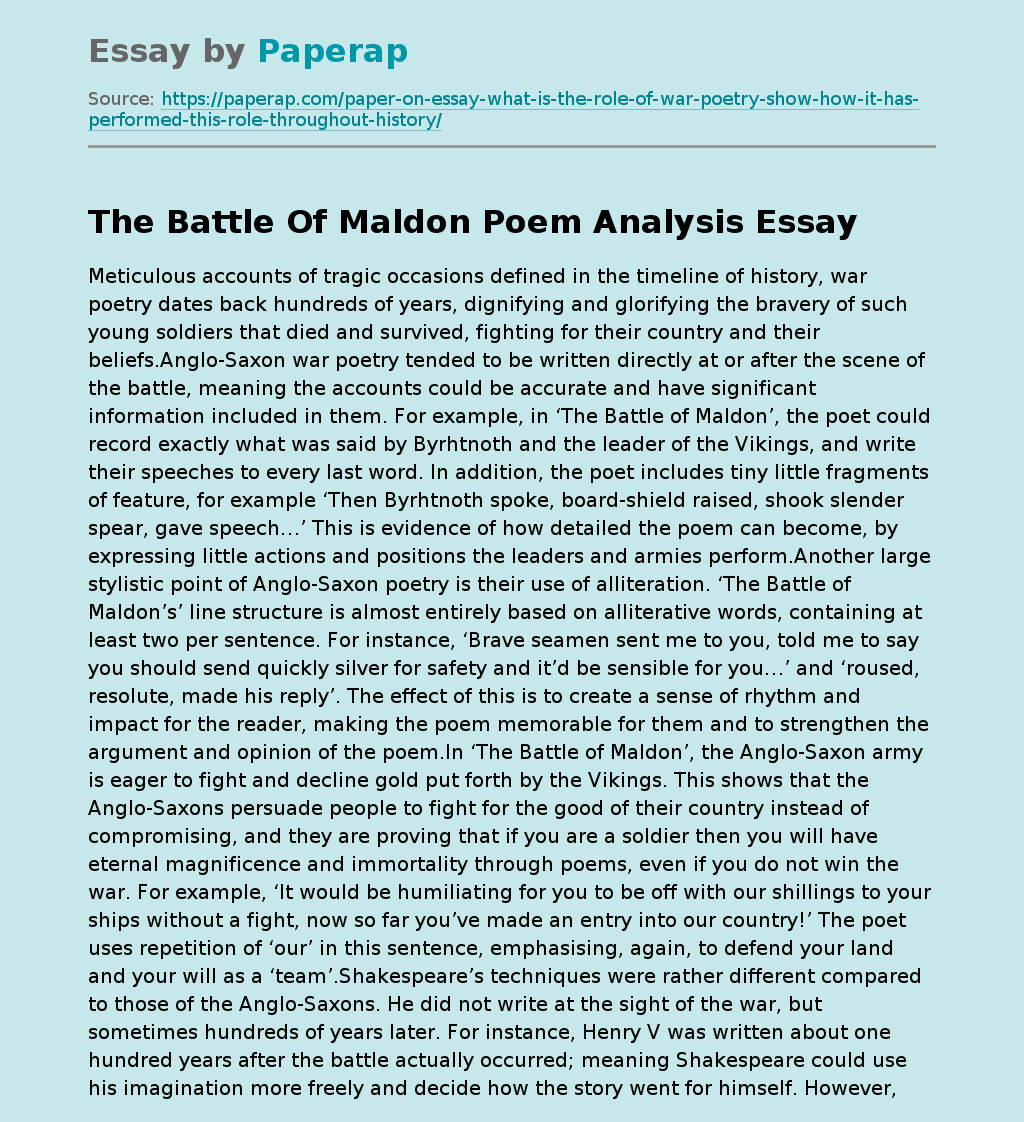The Battle Of Maldon Poem Analysis
Meticulous accounts of tragic occasions defined in the timeline of history, war poetry dates back hundreds of years, dignifying and glorifying the bravery of such young soldiers that died and survived, fighting for their country and their beliefs.Anglo-Saxon war poetry tended to be written directly at or after the scene of the battle, meaning the accounts could be accurate and have significant information included in them. For example, in ‘The Battle of Maldon’, the poet could record exactly what was said by Byrhtnoth and the leader of the Vikings, and write their speeches to every last word.
In addition, the poet includes tiny little fragments of feature, for example ‘Then Byrhtnoth spoke, board-shield raised, shook slender spear, gave speech…’ This is evidence of how detailed the poem can become, by expressing little actions and positions the leaders and armies perform.Another large stylistic point of Anglo-Saxon poetry is their use of alliteration. ‘The Battle of Maldon’s’ line structure is almost entirely based on alliterative words, containing at least two per sentence.
For instance, ‘Brave seamen sent me to you, told me to say you should send quickly silver for safety and it’d be sensible for you…’ and ‘roused, resolute, made his reply’. The effect of this is to create a sense of rhythm and impact for the reader, making the poem memorable for them and to strengthen the argument and opinion of the poem.In ‘The Battle of Maldon’, the Anglo-Saxon army is eager to fight and decline gold put forth by the Vikings.
This shows that the Anglo-Saxons persuade people to fight for the good of their country instead of compromising, and they are proving that if you are a soldier then you will have eternal magnificence and immortality through poems, even if you do not win the war. For example, ‘It would be humiliating for you to be off with our shillings to your ships without a fight, now so far you’ve made an entry into our country!’ The poet uses repetition of ‘our’ in this sentence, emphasising, again, to defend your land and your will as a ‘team’.Shakespeare’s techniques were rather different compared to those of the Anglo-Saxons. He did not write at the sight of the war, but sometimes hundreds of years later. For instance, Henry V was written about one hundred years after the battle actually occurred; meaning Shakespeare could use his imagination more freely and decide how the story went for himself. However, this could also result in the poem not being completely exact and significant pieces of detail being left out, leaving it up to Shakespeare to create his own twists in the story. The result is a more imaginative account.Another interesting difference between Henry V and ‘The Battle of Maldon’ is that Shakespeare’s Henry V was not written as propaganda, it was written for theatre. This is what Shakespeare mostly intended to write for. Therefore, rather than resembling poetry, his work was designed to be acted as a stage play and contained mainly long speeches and soliloquies, for example the St Crispin’s Day speech in Henry V.A huge distinction between the Charge of the Light Brigade and the Battle of Maldon is the rhyme. For instance, ‘Storm’d at with shot and shell, While horse and hero fell, They that had fought so well…’ Alliteration is used in the Battle of Maldon to give the poem a sense of rhythmic impact, whereas in the Charge of the Light Brigade, Tennyson used rhyme as an alternative. Consequently, the reader can read with more ease and direction, and there is a jollier, more regular rhythmic pattern to the poem.Another technique of ‘The Charge of the Light Brigade’ is its repetition. For example, ‘Flash’d all their sabres bare, Flash’das they turn’d in air’. The outcome of this poetic method is to emphasise light flashing on a sword, which is a visual image.’Disabled’ is a very contemporary poem in terms of vocabulary, grammar, image and style. It was written just after World War 1 by Wilfred Owen, probably the best known First World War poet. This poem is very different compared to the others. It uses lots of enjambment, the structure and meaning of the lines of poetry being carried directly over to the next line without a break. For example, ‘Only a solemn man who brought him fruits Thanked him; and then inquired about his soul.’ This is used effectively to create a feel of naturalistic motion in the poem.Furthermore, Owen’s use of depressing and vivid language and imagery give Disabled a much more disheartening tone than the other poems. For instance, ‘He sat in a wheeled chair, waiting for dark, And shivered in his ghastly suit of grey’. The effect of the saddening vocabulary, such as ‘dark’, ‘shivered’, ‘ghastly’ and ‘grey’, and style in and of the poem help create a sympathetic approach towards the soldier who’s lost all his limbs. It’s putting you in the position of the young man, which helps you to realise his pain.Some war poems encourage participation in war, some discourage it. There have been some vast changes in war poetry throughout the centuries for many different reasons, and many poets have been recognised for those changes. However, you still have to notice some of the big and little similarities between them, and acknowledge that through all that has happened in history, knowledge has been passed on from generation to generation through an incredible and demanding art.
The Battle Of Maldon Poem Analysis. (2019, Dec 05). Retrieved from https://paperap.com/paper-on-essay-what-is-the-role-of-war-poetry-show-how-it-has-performed-this-role-throughout-history/

